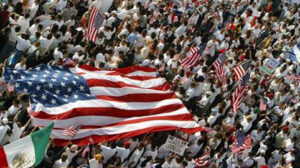
Credit: Associated Press, World Wide Photos. All rights reserved.
Mexico border.
The Immigration Act of 1990 increased legal immigration annually from 500,000 to 700,000, although it still favored those with family members already in the U.S. The measure strengthened the U.S. Border Patrol, but eliminated language that barred people with AIDs from entering the country. The Illegal Immigration Reform and Immigrant Responsibility Act of 1996 provided the framework for U.S. immigration policy that would follow in the post-9/11 era. In 1992, Congress passed the North American Free Trade Agreement (NAFTA) intended to create a free-trade bloc among the U.S., Canada and Mexico. However, the agreement raised concerns in the U.S. about immigration from south of the border. The 1996 Welfare Reform bill included anti-immigrant and other measures that eliminated many social services for undocumented immigrants. In 2001, the U.S. government initiated a series of immigration policies under the Patriot Act that were designed to thwart terrorism after the 9/11 attacks. The measure was again renewed in 2005, allowing the government greater latitude in suspending civil rights. Racial profilingthe use of race (and often nationality or religion) to identify a person as a... More, which for the most part had targeted blacks and Latinos, was extended to other groups, particularly Muslim, Arab and south Asian immigrants.
- By 1990 every resident of the U.S., according to the censusAn official count of a population and collection of demographic data. The United States Census... More, was one of four primary racial groups or other: White, Black/Negro, Native Indian/Native Alaskan, Asian or Other. However, the 1990 census categories included both racial and ethnic groups: Aleut, Asian Indian, Black or Negro, Chinese, Eskimo, Filipino, Guamanian, Hawaiian, Indian American, Japanese, Korean, Other, Other Asian Pacific Islander, Samoan, Vietnamese, White Hispanic origin of any racea recent idea created by western Europeans following exploration across the world to account for... More, and White, not of Hispanic origin.
- The four primary categories became five when Native Hawaiian/Pacific Islanders were separated from the Asian category in preparation for the 2000 census. But the most far-reaching change in the 2000 census was the multiple-race option. A person can be from two or more of the primary racial categories. “Mark one or more” converted six categories into 63, which when cross-tabulated by the ethnic category of Hispanic generated 126 categories of race/ethnicity. This was now policy for the entire federal statistical system. What for 200 years had been racial classificationthe practice of classifying people into distinct racial groups based on certain characteristics such as... More based on a small number of discrete groupings was no more. Insofar as race equals color, as it does in the minds of many, the multiple-race option transformed a categorical variable into something that resembled a continuous variable, with many shades of color now officially sanctioned.
- The 2000 census racial categories included: White, American Indian, Eskimo and Aleut, Asian and Pacific Islander, Black or African American, Other, Multiracial, Hispanic origin of any race, White, not of Hispanic origin.
- By 2005, four states had non-white majority populations-meaning more than half the state’s population was non-white: California, Texas, New Mexico and Hawaii. In California, Texas, and New Mexico, Mexican-Americans were the largest non-white group. In Hawaii the largest non-white group was Asian Americans. When combined with other minority groups, each state has a majority minority population.
- A bipartisan immigrationthe act of entering a country of which one is not a native to become... More legislation bill called the “Secure America and Orderly Immigration Act of 2005”-Senate bill 1033 and House bill 2330-was sponsored by senators Edward Kennedy (D-Mass.) and John McCain (R-Ariz.), and congressman and Luis Gutierrez (D-III.) among others, to restructure the immigration system and deal with undocumented workers. Undocumented immigrants who are currently living and working in the United States can achieve “legal’ status, according to a controversial stipulation of the bill. A new H-5B temporary visa program will be available for these workers, and they will be able to apply for permanent residency, leading to citizenship, after six years. They will face a minimum $2,000 penalty for their previously undocumented status, as well as numerous background checks and security tests. This process is significantly more stringent than was required in previous immigrant legalization legislation. An even more controversial provision of the bill is the Essential Worker Visa Program, a program that will allow approximately 400,000 guest workers annually into the U.S. to work in lowskill jobs. This program includes safeguards to help prevent displacement of American workers or the exploitation of the guest workers. Guest workers will be required to remain employed; if after leaving an unsatisfactory job they don’t find another within 60 days, they will be deported.

Credit: Biographical Directory of the United States Congress
“This bill is not amnesty. This bill does not provide a free pass to anyone. This bill does not give an automatic pardon to anyone. This bill does not put those that have been illegal that are here in the United States at the front of the line.”
– Senator Ted Kennedy
Senator Kennedy is a co-sponsor of an immigration reform bill that would restructure the immigration system and deal with undocumented workers.
Undocumented immigrants who are currently living and working in the United States can achieve legal status, according to one provision, but it is a more stringent process than required in previous immigrant legalization legislation. The most controversial element of the bill will allow approximately 400,000 guest workers annually into the U.S. to work in low-skill jobs.




